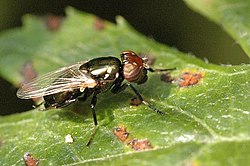| Physiphora alceae | |
|---|---|
 | |
| Scientific classification | |
| Kingdom: | Animalia |
| Phylum: | Arthropoda |
| Class: | Insecta |
| Order: | Diptera |
| Family: | Ulidiidae |
| Genus: | Physiphora |
| Species: | P. alceae |
| Binomial name | |
| Physiphora alceae (Preyssler, 1791) | |
Physiphora alceae is a species of ulidiid or picture-winged fly in the genus Physiphora of the family Ulidiidae. [1]